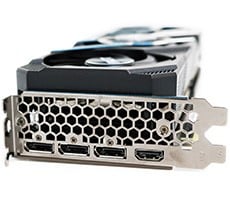AMD Radeon R9 295X2 Review: Hawaii x 2
3DMark Fire Strike has two benchmark modes: Normal mode runs at 1920x1080, while Extreme mode targets 2560x1440. GPU target frame buffer utilization for normal mode is 1GB and the benchmark uses tessellation, ambient occlusion, volume illumination, and a medium-quality depth of field filter. The more taxing Extreme mode targets 1.5GB of frame buffer memory and increases detail levels across the board. Extreme mode is explicitly designed for CrossFire / SLI systems. GT 1 focuses on geometry and illumination, with over 100 shadow casting spot lights, 140 non-shadow casting point lights, and 3.9 million vertices calculated for tessellation per frame. And 80 million pixels are processed per frame. GT2 emphasizes particles and GPU simulations. Tessellation volume is reduced to 2.6 million vertices and the number of pixels processed per frame rises to 170 million.
|
|
|

Once again, the Radeon R9 295X2 was able to outrun the dual-card Radeon R9 290X CrossFire configuration by a small margin. The GeForce GTX 780 Ti SLI setup came out on top in the 3DMark Fire Strike Extreme test, though. If you did into the individual results, you'll see that the 780 Ti SLI wins because of a higher FPS in GT1. In GT2, the Radeon R9 295X2 is fastest.








